Post by Sabertooth on Apr 30, 2019 22:03:17 GMT -5
I found a neat guide on DOHC swapping, and figured it would be useful here. Honestly, it doesn't look very hard at all. It seems to suggest that to DOHC swap the 4G69, you wouldn't need to change timing belt length or use 4G64 DOHC cam gears either. Standard 4G63 7 bolt head stuff seems like a bolt on.
I didn't write this out, credit goes to the source.
Source: eatsleepdsmmag.com/4g64-dohc-head-swap-faq/
Cylinder Head
The cylinder head you choose to go with will essentially determine the rest of the parts you use. The most common head to use is the 2G head as it can make the swap somewhat easier. The 2G 2.4L 4G64 engine is a 7 bolt engine, just like the 2G 4G63. This means that the head bolt holes are the same size and uses the same head bolts/studs. The 6 bolt head bolt holes are 1mm larger, but you can still use a 1G head on any 2G block. The reason is because the head bolt holes in the 1g head are bigger, but it won’t matter as you will still be using the smaller 7 bolt head bolt/stud.
If you were to do the opposite and use a 2G head on a 6 bolt engine, you would have to use the 6 bolt head bolts/studs. Well, the larger 6 bolt bolts/studs will not fit through the 2G head because the holes in it are too small.So to accommodate this, you need to bore the 7 bolt head bolt holes 1mm larger to accept the 6 bolt head bolt/studs.
There are plenty of different options that you have. The most important factor in determining which head will best suit your setup will be based off of compression. Port sizes, combustion chamber, flow rates, designs in manifolds, etc. all play a role in compression. The 2.4L 4G64 has much higher compression than the 4G63 because of the extra displacement. The rule of thumb is, higher compression means more low RPM, low boost power. The lower the compression, the more power you make at higher RPM, at higher boost. Beings the SOHC 4G64 from a 2G was meant to be NA, it already has high compression. With the right combination of parts, you could help lower the compression ratio a tad so the engine is more responsive to higher boost.
Oil Return Holes on SOHC 4G64 Deck
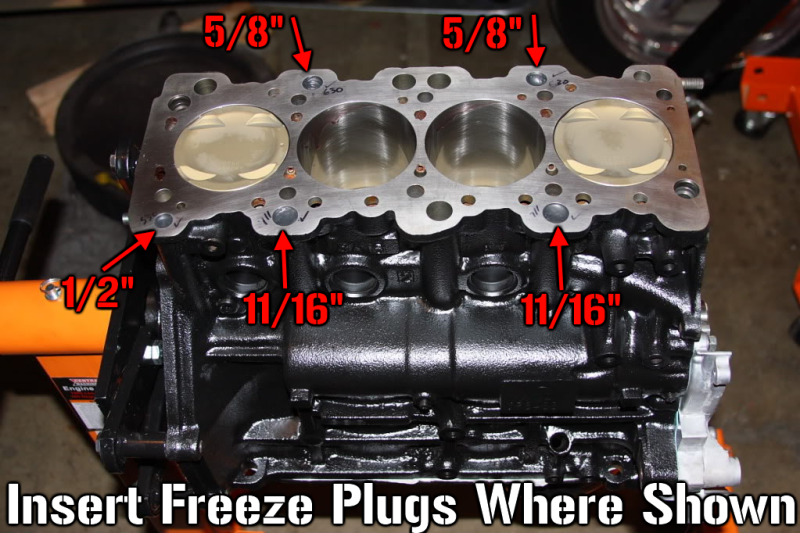
Most of the swap is straight forward as nearly all parts are direct bolt-on. But, there are a few modifications you need to make to you’re 4G64. One of the more crucial modifications required is the blocking of the oil return holes on the deck of the SOHC 4G64. The 7 bolt, SOHC blocks have oil return holes that the DOHC 4G64 and the 4G63, do not have. So, these holes need to be plugged.
The reason being is because after you bolt the DOHC head onto the 4G63 SOHC, these holes are not completely covered by the head. So, they are partially exposed. Though these holes are not high pressure holes, they still need to be plugged. If not, dirt, dust, water, fuel, coolant, and other elements are easily able to fall into these holes. These holes are a direct passage way to the crankcase. I would imagine that under higher boost levels, or maybe any boost levels, oil would be blown out of these holes due to excessive crankcase pressure, just like if you drove without a dipstick.
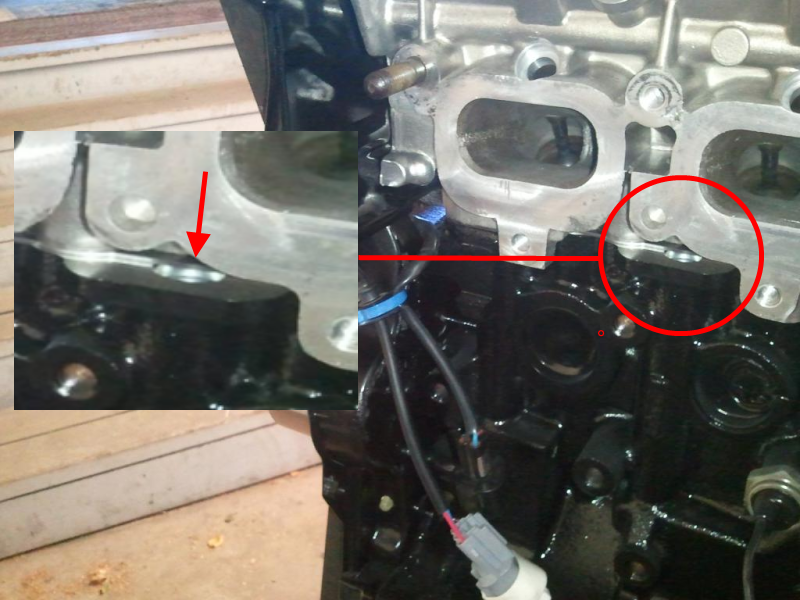
There are a couple ways you can go about plugging these holes. If you are taking your engine to the machine shop, just have them do it. What they will do is drill out the hole slightly, tap it, then thread a plug that will be recessed down into the hole.

The most common way to plug these holes quicker, easier, and more of a DIY modification, uses regular freeze plugs. You can simply drill the holes out slightly bigger, then install the correct size freeze plugs.
The sizes are:
(1) 1/2″ Freeze Plug
(2) 5/8″ Freeze Plugs
(2) 11/16″ Freeze Plugs
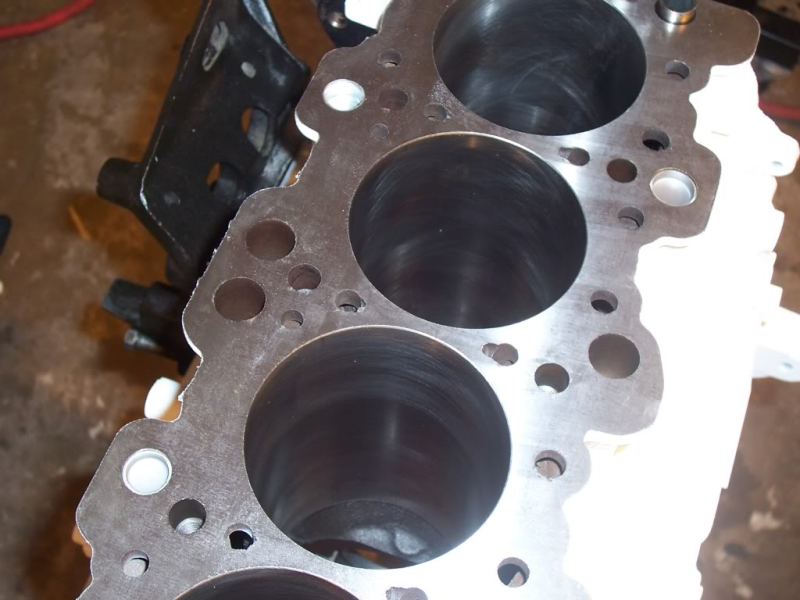
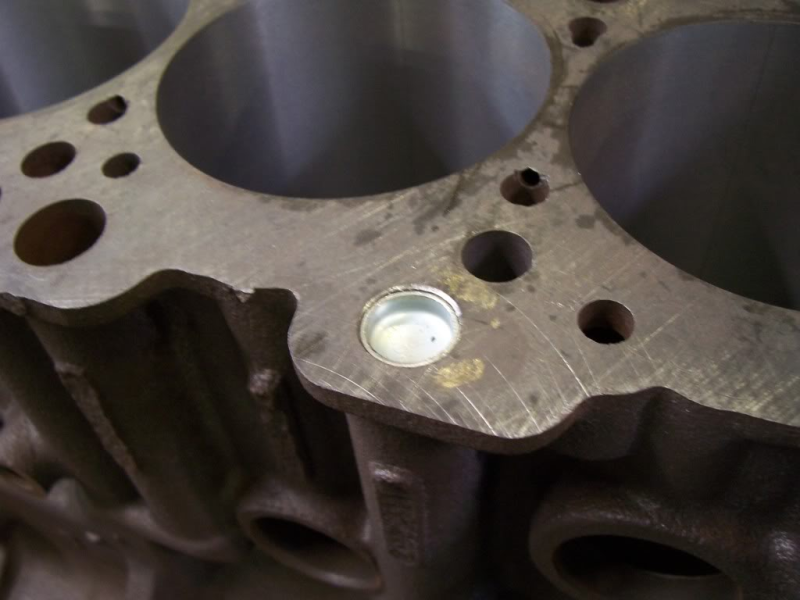
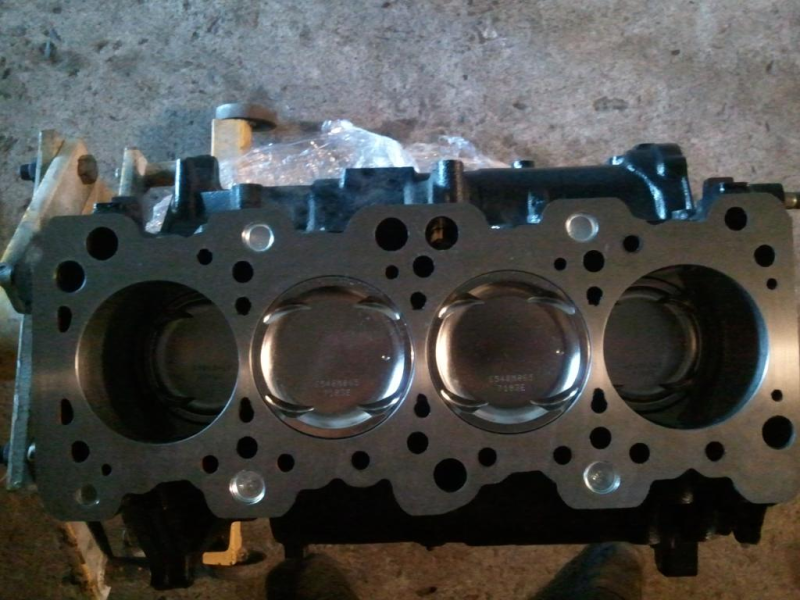
Head Gasket

You will need to use the DOHC 4G64 head gasket. The 4G64 engines have a 86.5mm cylinder bore. The 4G63 has a 85mm bore. Because of the big difference in bore size, it is best to use the DOHC 4G64 head gasket to avoid any complications.
You can, however, use a 4G63 head gasket that has a larger bore size. All of your standard and OEM 4G63 head gaskets have a 86mm bore. This allows them to work on a 4G63 that has been bored all the way up to .40 over. There are several 4G63 MLS head gaskets available, like the Felpro Permatourque MLS head gasket, that have a 87mm bore. This would work fine on the 4G64 with a 4G63 head, but they are pricey.
Any standard 4G64 DOHC head gasket from the parts store will work fine. Just tell them you need a head gasket for a 1994 Mitsubishi Galant GS with the 2.4L DOHC engine.
I also have heard of people using the 4G64 SOHC head gasket from the Spyder and filling in the unused oil return holes with copper spray (I used copper spray on ALL of my head gaskets), though I would not use this option. But, it was worth a mention.
Timing Components
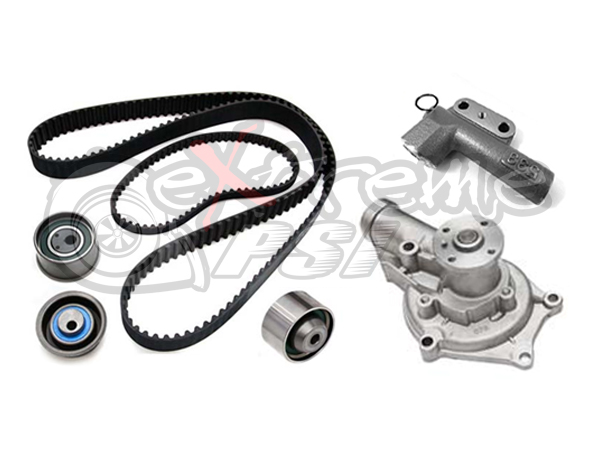
The next thing up for discussion is the timing system. There will also be many needed changes to the timing system being that you are going from SOHC to DOHC and again, you have a couple of different options here.
Lets begin with the timing gears. The easiest and probably the safest option for cam gears would be to use a set of DOHC 4G64 cam gears out of a 1994 Mitsubishi Galant GS. If you can’t find these used, which you can bet on not finding them used as the DOHC 4G64’s are hard to come by, they are about $33 a piece on extremepsi.com, brand new OEM. If you use the DOHC 4G64 cam gears, you won’t need to modify the timing marks. This ensures an error-proof timing install.
DOHC 4G64 Exhaust Cam Gear
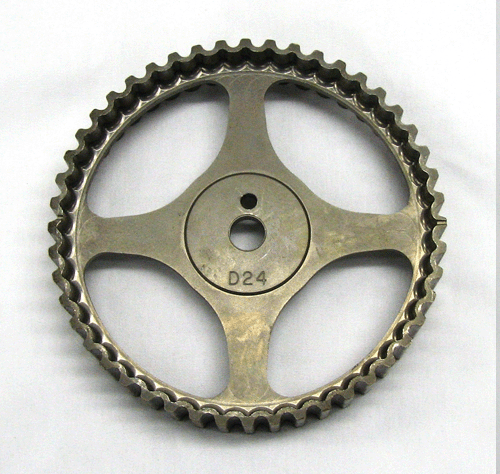
DOHC 4G64 Intake Cam Gear

Now, with that said, I need to disclose the fact that you can use the 4G63 cam gears if needed. But when using the 4G63 cam gears, each cam gear timing mark MUST be advanced a half a tooth. You can simply make a new timing mark with white out or a paint pen on each gear to provide a more accurate and visible timing mark.
You will also need to use the DOHC 4G64 timing belt, again from the 1994 DOHC 4G64 Galant. The 4g64 has a taller deck height compared to the 4G63. This calls for a slightly longer timing belt. As for the rest of the timing belt components, you will use 95-99 timing parts. It is easier to buy the full kit that comes with everything, but without the timing belt of course. Extreme PSI sells the full timing belt kits. If you call them and tell them you need the 95-99 DSM timing belt kit but you need the 4G64 DOHC timing belt, I am sure they will sell you a kit with that belt instead of having to buy everything separate. The full list of the timing belt components needed is below:
Timing Belt: 4G64 DOHC- www.extremepsi.com/store/product.php?productid=20265&cat=0&page=1
Timing belt auto hydraulic tensioner: Early 95- www.extremepsi.com/store/product.php?productid=21146&cat=0&page=1 95-99- www.extremepsi.com/store/product.php?productid=18426&cat=0&page=1
Timing belt tensioner pulley: 2G 95-99- www.extremepsi.com/store/product.php?productid=18429&cat=0&page=1
Timing belt idler pulley: DSM 90-99- www.extremepsi.com/store/product.php?productid=18918&cat=0&page=
4G64 intake cam gear: 94 Galant GS www.extremepsi.com/store/product.php?productid=20294&cat=0&page=1
4G64 exhaust cam gear: 94 Galant GS- www.extremepsi.com/store/product.php?productid=20293&cat=865
Just because I find this extremely interesting, and slightly stupid, I want to show you how some people have made the 4G63 cam gears and 4G63 timing belt work. Instead of doing it the right way, they decided to remove the idler pulley and install a second tensioner pulley to get the proper slack and adjustment out of using the 4G63 belt. It’s bad enough when you have to worry about one tensioner pulley failing, let alone two. Fuck that!
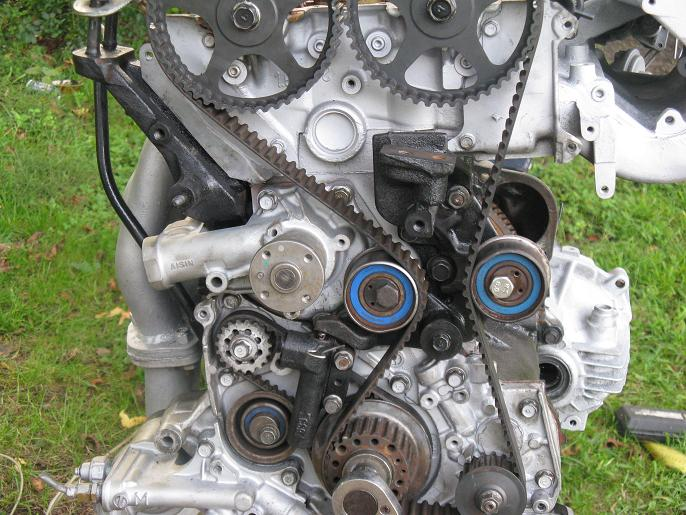
Turbo and Related Parts
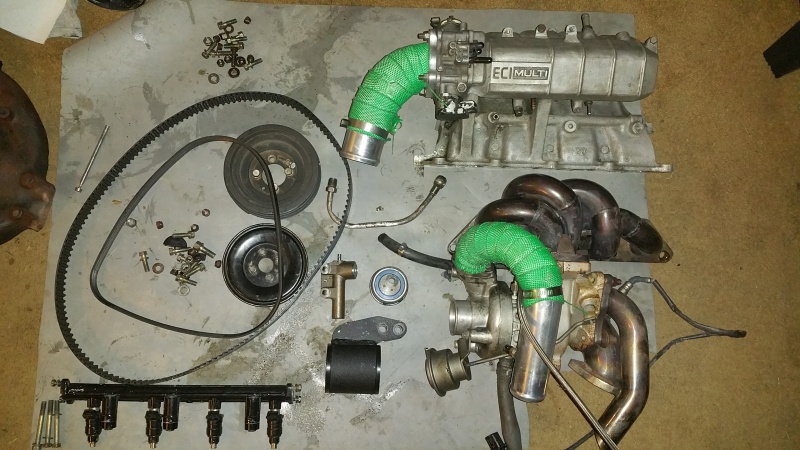
Turbo- What you are doing for a turbo is up to you as you literally have hundreds of options. I will cover the basics with a simple, stock DSM flange turbo. And even then, you still have plenty of options. If you want to keep things simple, which you should if you are going to be using the fragile 4G64 NA pistons, use a factory 1G 14b turbo or a 2G t25 turbo. Whichever you decide, you will need the matching hotside and the matching internal wastegate.
Exhaust Manifold- For the exhaust manifold, use either a 1G or 2G exhaust manifold. The 2G exhaust manifolds flow better than the 1G, so the 2g manifold would be the better choice of the two. You can however, use any DSM flange exhaust manifold or header.
O2 Housing- You will need a DSM O2 housing.
Intake Manifold- The intake manifold, you really only have one option as far as stock form intake manifolds. You need to use the intake that matches the head you are using. If you are using a 1g cylinder head, you need to use the 1G intake manifold. If you are using the 2G head, you need to use the 2G intake manifold.
Fuel Rail- You will need the fuel rail that matches your intake manifold. Make sure to get the FPR (Fuel Pressure Regulator) along with the fuel rail. The FPR is attached to the driver side of the rail.
Injector Resistor Box- You will need to use the 2G 4G63 injector resistor box.
Fuel Injectors- You will need 1G or 2G 450cc. fuel injectors. I would highly suggest getting these o-rings and other hardware for the injectors as well, www.extremepsi.com/store/product.php?productid=17787 (NOTE- These will come in your complete top end head gasket set)
Throttle Body- You can use your 4G64 throttle body (TB), but it is highly recommended that you use a 4G63 TB. The 1G TB is the best out two 4G63 options as the 1G TB is bigger (60mm) than the 2G TB (52mm). If you are using a 1G head, there are some minor modifications needed to the valve ports on the 2G TB that is required in order to use the 2G TB on the 1G intake. If you swap the TB, you need to use the matching TPS (Throttle Position Sensor).
Water Pipe/Thermostat Housing- You need to swap a 4G63 water pipe and thermostat housing as well. This is because the turbo needs it’s coolant lines, feed and return, hooked up in order to utilize the coolant cooled functions that is given to the 4G63 DSM’s from the factory. There are plenty of people that have proven that you do not necessarily need coolant lines on the stock turbos and have deleted them all together. This may not be suggested, but it is an option.
Turbo Coolant Feed Line- www.extremepsi.com/store/product.php?productid=20763&cat=0&page=1
Turbo Coolant Return Line- www.extremepsi.com/store/product.php?productid=20762&cat=0&page=1
Radiator Hoses- Along with the water pipe and thermostat housing, you need the matching radiator hoses for whatever water pipe and thermostat housing you choose to go with.
Radiator- You will have to use the 2G 4G63 radiator, or a 1G radiator. The 1G radiator is better, but requires VERY LITTLE modification.
Turbo Oil Feed Line- In addition to turbo coolant lines, you need turbo oil and feed lines. These aren’t optional and you NEED to use them. If not, you will destroy your turbo within minutes. The lines you need are aftermarket. The feed line can be purchased here www.extremepsi.com/store/product.php?productid=19248 . Just be sure to select which turbo fitting you are using in the drop down menu.
Turbo Oil Return Line- For the turbo oil return line, there are dozens and dozens of different types, styles, etc. Here is an example of one, www.extremepsi.com/store/product.php?productid=17785&cat=0&page=1 . Again, be sure to select the correct fittings for the turbo you are using.
Oil Pan- You will need a 2G 4G63 oil pan as the 4G64 oil pan does not have the flange for the turbo return line.
MAF- You will need a 2G MAF, air filter, and intake pipe. These can be found online, used, for cheap. Check on the facebook group.
Intercooler- Intercooler piping and an intercooler will obviously be needed. You can source out a stock 2G side mount intercooler with piping or buy a nice FMIC (Front Mount Intercooler) kit with piping. STAY OFF EBAY.
Blow Off Valve- You will need a BOV (Blow Off Valve). You can simply use the 1G or 2G BOV. The 2G plastic BOV is garbage BTW, the 1G BOV’s are amazing. Make sure you intercooler piping has the correct flange for the BOV you select.
Water Pump- You will need to replace the water pump while you are doing the timing. OEM and Gates are the only brands that should be trusted.
CAS- You will need a 4G63 CAS (Cam Angle Sensor). The best and easiest IMO is to wire up a 1G CAS. The 1G CAS bolts to the passenger side of the valve cover at the end of the intake cam. This is adjustable and easy to get to. The 2G cam and crank sensors can be used as well.
Coil Pack- A 4G63 coil pack is required. 1G or 2G, it’d be better to get the one that matches the intake manifold you select.
ECU- You will need to use a 2G 4G63 ECU. The black box ECU is the best as it is flashable with ECUflash. A regular 2G ECU will be fine to get you going in stock form though.
Knock Sensor- You will need to add a knock sensor into your wiring harness. You can use the 2G knock sensor.
Front O2 Sensor- You will need a 2g 4G63 front o2 sensor.
I didn't write this out, credit goes to the source.
Source: eatsleepdsmmag.com/4g64-dohc-head-swap-faq/
Cylinder Head
The cylinder head you choose to go with will essentially determine the rest of the parts you use. The most common head to use is the 2G head as it can make the swap somewhat easier. The 2G 2.4L 4G64 engine is a 7 bolt engine, just like the 2G 4G63. This means that the head bolt holes are the same size and uses the same head bolts/studs. The 6 bolt head bolt holes are 1mm larger, but you can still use a 1G head on any 2G block. The reason is because the head bolt holes in the 1g head are bigger, but it won’t matter as you will still be using the smaller 7 bolt head bolt/stud.
If you were to do the opposite and use a 2G head on a 6 bolt engine, you would have to use the 6 bolt head bolts/studs. Well, the larger 6 bolt bolts/studs will not fit through the 2G head because the holes in it are too small.So to accommodate this, you need to bore the 7 bolt head bolt holes 1mm larger to accept the 6 bolt head bolt/studs.
There are plenty of different options that you have. The most important factor in determining which head will best suit your setup will be based off of compression. Port sizes, combustion chamber, flow rates, designs in manifolds, etc. all play a role in compression. The 2.4L 4G64 has much higher compression than the 4G63 because of the extra displacement. The rule of thumb is, higher compression means more low RPM, low boost power. The lower the compression, the more power you make at higher RPM, at higher boost. Beings the SOHC 4G64 from a 2G was meant to be NA, it already has high compression. With the right combination of parts, you could help lower the compression ratio a tad so the engine is more responsive to higher boost.
Oil Return Holes on SOHC 4G64 Deck

Most of the swap is straight forward as nearly all parts are direct bolt-on. But, there are a few modifications you need to make to you’re 4G64. One of the more crucial modifications required is the blocking of the oil return holes on the deck of the SOHC 4G64. The 7 bolt, SOHC blocks have oil return holes that the DOHC 4G64 and the 4G63, do not have. So, these holes need to be plugged.
The reason being is because after you bolt the DOHC head onto the 4G63 SOHC, these holes are not completely covered by the head. So, they are partially exposed. Though these holes are not high pressure holes, they still need to be plugged. If not, dirt, dust, water, fuel, coolant, and other elements are easily able to fall into these holes. These holes are a direct passage way to the crankcase. I would imagine that under higher boost levels, or maybe any boost levels, oil would be blown out of these holes due to excessive crankcase pressure, just like if you drove without a dipstick.

There are a couple ways you can go about plugging these holes. If you are taking your engine to the machine shop, just have them do it. What they will do is drill out the hole slightly, tap it, then thread a plug that will be recessed down into the hole.

The most common way to plug these holes quicker, easier, and more of a DIY modification, uses regular freeze plugs. You can simply drill the holes out slightly bigger, then install the correct size freeze plugs.
The sizes are:
(1) 1/2″ Freeze Plug
(2) 5/8″ Freeze Plugs
(2) 11/16″ Freeze Plugs



Head Gasket

You will need to use the DOHC 4G64 head gasket. The 4G64 engines have a 86.5mm cylinder bore. The 4G63 has a 85mm bore. Because of the big difference in bore size, it is best to use the DOHC 4G64 head gasket to avoid any complications.
You can, however, use a 4G63 head gasket that has a larger bore size. All of your standard and OEM 4G63 head gaskets have a 86mm bore. This allows them to work on a 4G63 that has been bored all the way up to .40 over. There are several 4G63 MLS head gaskets available, like the Felpro Permatourque MLS head gasket, that have a 87mm bore. This would work fine on the 4G64 with a 4G63 head, but they are pricey.
Any standard 4G64 DOHC head gasket from the parts store will work fine. Just tell them you need a head gasket for a 1994 Mitsubishi Galant GS with the 2.4L DOHC engine.
I also have heard of people using the 4G64 SOHC head gasket from the Spyder and filling in the unused oil return holes with copper spray (I used copper spray on ALL of my head gaskets), though I would not use this option. But, it was worth a mention.
Timing Components

The next thing up for discussion is the timing system. There will also be many needed changes to the timing system being that you are going from SOHC to DOHC and again, you have a couple of different options here.
Lets begin with the timing gears. The easiest and probably the safest option for cam gears would be to use a set of DOHC 4G64 cam gears out of a 1994 Mitsubishi Galant GS. If you can’t find these used, which you can bet on not finding them used as the DOHC 4G64’s are hard to come by, they are about $33 a piece on extremepsi.com, brand new OEM. If you use the DOHC 4G64 cam gears, you won’t need to modify the timing marks. This ensures an error-proof timing install.
DOHC 4G64 Exhaust Cam Gear

DOHC 4G64 Intake Cam Gear

Now, with that said, I need to disclose the fact that you can use the 4G63 cam gears if needed. But when using the 4G63 cam gears, each cam gear timing mark MUST be advanced a half a tooth. You can simply make a new timing mark with white out or a paint pen on each gear to provide a more accurate and visible timing mark.
You will also need to use the DOHC 4G64 timing belt, again from the 1994 DOHC 4G64 Galant. The 4g64 has a taller deck height compared to the 4G63. This calls for a slightly longer timing belt. As for the rest of the timing belt components, you will use 95-99 timing parts. It is easier to buy the full kit that comes with everything, but without the timing belt of course. Extreme PSI sells the full timing belt kits. If you call them and tell them you need the 95-99 DSM timing belt kit but you need the 4G64 DOHC timing belt, I am sure they will sell you a kit with that belt instead of having to buy everything separate. The full list of the timing belt components needed is below:
Timing Belt: 4G64 DOHC- www.extremepsi.com/store/product.php?productid=20265&cat=0&page=1
Timing belt auto hydraulic tensioner: Early 95- www.extremepsi.com/store/product.php?productid=21146&cat=0&page=1 95-99- www.extremepsi.com/store/product.php?productid=18426&cat=0&page=1
Timing belt tensioner pulley: 2G 95-99- www.extremepsi.com/store/product.php?productid=18429&cat=0&page=1
Timing belt idler pulley: DSM 90-99- www.extremepsi.com/store/product.php?productid=18918&cat=0&page=
4G64 intake cam gear: 94 Galant GS www.extremepsi.com/store/product.php?productid=20294&cat=0&page=1
4G64 exhaust cam gear: 94 Galant GS- www.extremepsi.com/store/product.php?productid=20293&cat=865
Just because I find this extremely interesting, and slightly stupid, I want to show you how some people have made the 4G63 cam gears and 4G63 timing belt work. Instead of doing it the right way, they decided to remove the idler pulley and install a second tensioner pulley to get the proper slack and adjustment out of using the 4G63 belt. It’s bad enough when you have to worry about one tensioner pulley failing, let alone two. Fuck that!

Turbo and Related Parts

Turbo- What you are doing for a turbo is up to you as you literally have hundreds of options. I will cover the basics with a simple, stock DSM flange turbo. And even then, you still have plenty of options. If you want to keep things simple, which you should if you are going to be using the fragile 4G64 NA pistons, use a factory 1G 14b turbo or a 2G t25 turbo. Whichever you decide, you will need the matching hotside and the matching internal wastegate.
Exhaust Manifold- For the exhaust manifold, use either a 1G or 2G exhaust manifold. The 2G exhaust manifolds flow better than the 1G, so the 2g manifold would be the better choice of the two. You can however, use any DSM flange exhaust manifold or header.
O2 Housing- You will need a DSM O2 housing.
Intake Manifold- The intake manifold, you really only have one option as far as stock form intake manifolds. You need to use the intake that matches the head you are using. If you are using a 1g cylinder head, you need to use the 1G intake manifold. If you are using the 2G head, you need to use the 2G intake manifold.
Fuel Rail- You will need the fuel rail that matches your intake manifold. Make sure to get the FPR (Fuel Pressure Regulator) along with the fuel rail. The FPR is attached to the driver side of the rail.
Injector Resistor Box- You will need to use the 2G 4G63 injector resistor box.
Fuel Injectors- You will need 1G or 2G 450cc. fuel injectors. I would highly suggest getting these o-rings and other hardware for the injectors as well, www.extremepsi.com/store/product.php?productid=17787 (NOTE- These will come in your complete top end head gasket set)
Throttle Body- You can use your 4G64 throttle body (TB), but it is highly recommended that you use a 4G63 TB. The 1G TB is the best out two 4G63 options as the 1G TB is bigger (60mm) than the 2G TB (52mm). If you are using a 1G head, there are some minor modifications needed to the valve ports on the 2G TB that is required in order to use the 2G TB on the 1G intake. If you swap the TB, you need to use the matching TPS (Throttle Position Sensor).
Water Pipe/Thermostat Housing- You need to swap a 4G63 water pipe and thermostat housing as well. This is because the turbo needs it’s coolant lines, feed and return, hooked up in order to utilize the coolant cooled functions that is given to the 4G63 DSM’s from the factory. There are plenty of people that have proven that you do not necessarily need coolant lines on the stock turbos and have deleted them all together. This may not be suggested, but it is an option.
Turbo Coolant Feed Line- www.extremepsi.com/store/product.php?productid=20763&cat=0&page=1
Turbo Coolant Return Line- www.extremepsi.com/store/product.php?productid=20762&cat=0&page=1
Radiator Hoses- Along with the water pipe and thermostat housing, you need the matching radiator hoses for whatever water pipe and thermostat housing you choose to go with.
Radiator- You will have to use the 2G 4G63 radiator, or a 1G radiator. The 1G radiator is better, but requires VERY LITTLE modification.
Turbo Oil Feed Line- In addition to turbo coolant lines, you need turbo oil and feed lines. These aren’t optional and you NEED to use them. If not, you will destroy your turbo within minutes. The lines you need are aftermarket. The feed line can be purchased here www.extremepsi.com/store/product.php?productid=19248 . Just be sure to select which turbo fitting you are using in the drop down menu.
Turbo Oil Return Line- For the turbo oil return line, there are dozens and dozens of different types, styles, etc. Here is an example of one, www.extremepsi.com/store/product.php?productid=17785&cat=0&page=1 . Again, be sure to select the correct fittings for the turbo you are using.
Oil Pan- You will need a 2G 4G63 oil pan as the 4G64 oil pan does not have the flange for the turbo return line.
MAF- You will need a 2G MAF, air filter, and intake pipe. These can be found online, used, for cheap. Check on the facebook group.
Intercooler- Intercooler piping and an intercooler will obviously be needed. You can source out a stock 2G side mount intercooler with piping or buy a nice FMIC (Front Mount Intercooler) kit with piping. STAY OFF EBAY.
Blow Off Valve- You will need a BOV (Blow Off Valve). You can simply use the 1G or 2G BOV. The 2G plastic BOV is garbage BTW, the 1G BOV’s are amazing. Make sure you intercooler piping has the correct flange for the BOV you select.
Water Pump- You will need to replace the water pump while you are doing the timing. OEM and Gates are the only brands that should be trusted.
CAS- You will need a 4G63 CAS (Cam Angle Sensor). The best and easiest IMO is to wire up a 1G CAS. The 1G CAS bolts to the passenger side of the valve cover at the end of the intake cam. This is adjustable and easy to get to. The 2G cam and crank sensors can be used as well.
Coil Pack- A 4G63 coil pack is required. 1G or 2G, it’d be better to get the one that matches the intake manifold you select.
ECU- You will need to use a 2G 4G63 ECU. The black box ECU is the best as it is flashable with ECUflash. A regular 2G ECU will be fine to get you going in stock form though.
Knock Sensor- You will need to add a knock sensor into your wiring harness. You can use the 2G knock sensor.
Front O2 Sensor- You will need a 2g 4G63 front o2 sensor.

